What's in Your Whey?
Label Checking to Get the Best Whey
Not all whey proteins are created equal. This page will help you know what to look for and what to avoid when buying whey protein. After all, since your making an effort to take good care of your body, you want to make sure it likes what your putting into it.
Less is more...
A high quality whey protein should only have the following ingredients:
- Undenatured Whey Protein
- Flavoring
- Sweetener
... and meet the following criteria;
- Sourced from Organic Grass Fed Cows
- Be Undenatured whey protein
- Contain no artificial sweeteners
- Contain no added sugars
- Contain no soy
So with this in mind I randomly gathered and analysed ingredient labels from a few dozen whey protein powders on the market. I've selected 7 and shown them below with red boxes to highlight ingredients you should be cautious about.
Remember... less is more. The ingredients in red do not need to be in the powder and will not support your health goals.
Source of Whey
The best whey protein comes from grass fed cows that have not been given antibiotics or growth hormones. Whey from New Zealand is known to be some of the best in the world, exceeding USDA Organic standards. Any manufacturer using New Zealand sourced whey will prominently indicate it somewhere on the whey protein label. The same can be said if organic whey is used.
If the label does not say New Zealand or organic whey, then it isn’t.
Undenatured
Undenatured whey protein has not been pasteurized and preserves the natural delicate protein structures. High quality products will explicitly say on the label "undenatured whey". If not labelled undenatured, assume it’s not and look for a different product.
It's worth paying a bit extra for undenatured whey protein powder.
|
Artificial Sweeteners With the mounting evidence concerning the health risks of artificial sweeteners, a high quality whey protein should not include any of the following sweeteners on its whey protein label. Acesulfame Potassium, also shown on ingredient labels as acesulfame K or ACE or under the brand names Sunette, Sweet One or Sweet’n Safe. The sweetener is known to contain the carcinogen, Methylene Chloride, which is commonly used as a paint stripper, degreaser and an additive in gas. Studies linking Acesulfame-K to different types of tumors, leukemia and chronic respiratory disease in animals are still being debated. Despite controversial findings and the need for further study, the sweetener was approved for human consumption. Aspartame, sold under the brand names NutraSweet, Equal, Spoonful or Equal-Measure, releases methyl alcohol or methanol into the blood stream. The methanol (commonly called wood alcohol) then passes into your blood-brain barrier and is converted into formaldehyde (embalming fluid) which causes damage. Neotame was developed by Monsanto Chemical Corp with a chemical structure similar to aspartane. Even though no long term studies have been done, researchers expect it to be even more toxic than aspartame. Sucralose is another popular sweetener sold as a sugar substitute known as Splenda and is 600 times sweeter than table sugar. Sucralose is a synthetic compound, which is basically sugar that has been modified by adding chlorine atoms. Reports on the negative health effects of sucralose are increasing. Sucralose has been shown to destroy 50% the good bacteria in the intestines which support a healthy body. Saccharin and Cyclamate should be avoided. They have been banned in Canada and many other countries. Corn Syrup and corn syrup solids were introduced in 1970 as a cheaper alternative to using sugar. Coincidentally, this coincides with the beginning of today's obesity trend. They are commonly referred to as HFCS (High Fructose Corn Syrup). In Canada, it is listed on labels as fructose/ glucose. There is ongoing debate over HFCS’s impact on health. With HFCS added as a cheap sweetener in so many products, the primary concern is the huge quantity being consumed on a daily basis. 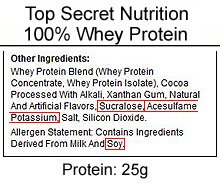 |
 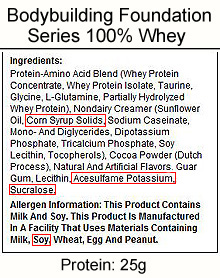 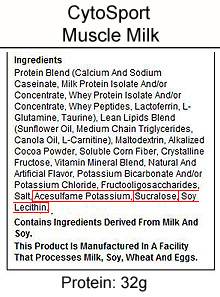 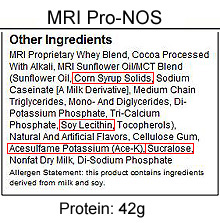 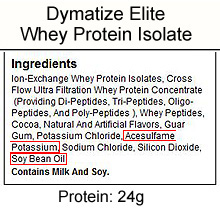 |
Natural & Novel Sweetener Solutions:
Look for whey protein labels that use natural sweeteners such as Agava nectar, Date Sugar, Fruit Juice Concentrate, Honey, Maple syrup, Molasses or novel sweeteners such as Stevia extracts (Pure Via, Truvia), Tagatose (Nuturlose) or Trehalose.
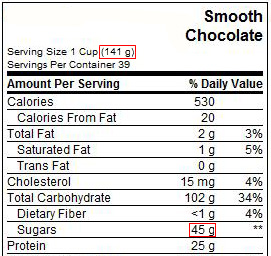
Sugar Content
In some products the actual sugar content is disguised. The serving size may be shown in one unit of measure and the sugar content in a different unit of measure. In the label to the right, notice the serving size as 1 cup (141g) and sugars as 45g. This means that for every cup of this whey protein powder you get 1/3 cup of sugar. That’s a lot of sugar per serving.
Soy Lecithin
New studies are showing that soy protein is not as good for your health as advertised by the producers of soy. Most soy used in the US (about 90%) has been genetically modified (GM). Concerns over the potential long-term effects of eating GM foods are being shown in recent studies.
A compound of soy lecithin, phytoestrogen, simulates human estrogen. Studies have linked this to thyroid dysfunction, reproductive disorders, digestive problems, immune system breakdowns, heart disease, brain development in infants and increased risk of cancer.
Examine the whey protein label for any mention of soy or soy lecithin.
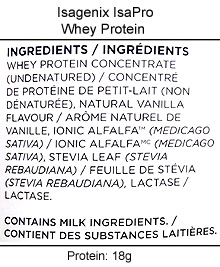
My favorite Whey Protein
The Isagenix IsaPro Whey Protein has everything I look for and nothing I don't want in a high quality whey protein.
- undenatured whey protein sourced from New Zealand grass fed cows
- natural vanila flavouring
- stevia leaf sweetener
The only extra ingredient on the label is Ionic Alfalfa. This is a proprietary combination of more than 70 plant source minerals and alfalfa juice extract that enhances and improves bio-availibility.
Click here for more on Isagenix IsaPro.
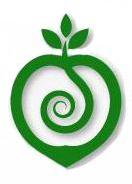
Click on the link below to go directly to the best whey protein on the market today and get wholesale pricing.
Over 90% bioavailable to muscles!
We welcome your questions /comments:
Click here to contact.
DID YOU KNOW?
"Whey protein is the highest quality of proteins because it contains the perfect combination of overall amino acids."
Feel Good About Yourself
(CD)
The Feel Good About Yourself CD contains 3 specially selected hypnosis sessions.





